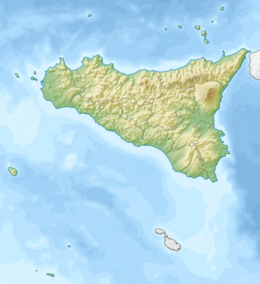1693 Sicily earthquake
 |
|
| Date | January 11, 1693 |
|---|---|
| Origin time | 21:00 |
| Magnitude | 7.4 Mw |
| Epicenter |
37°18′N 15°06′E / 37.3°N 15.1°ECoordinates: 37°18′N 15°06′E / 37.3°N 15.1°E The exact location of the epicentre remains uncertain |
| Areas affected | Southern Italy, notably Sicily, and Malta |
| Max. intensity | XI (Extreme) |
| Tsunami | 5–10 meter high waves devastated the coastal villages on the Ionian Sea and in the Straits of Messina. (Ambraseys-Sieberg intensity V tsunami) |
| Foreshocks | A magnitude 6.2 on January 9 |
| Casualties | 60,000 deaths |
The 1693 Sicily earthquake struck parts of southern Italy near Sicily, Calabria and Malta on January 11 at around 21:00 local time. This earthquake was preceded by a damaging foreshock on January 9. It had an estimated magnitude of 7.4 on the moment magnitude scale, the most powerful in Italian history, and a maximum intensity of XI (Extreme) on the Mercalli intensity scale, destroying at least 70 towns and cities, seriously affecting an area of 5,600 square kilometres (2,200 sq mi) and causing the death of about 60,000 people. The earthquake was followed by tsunamis that devastated the coastal villages on the Ionian Sea and in the Straits of Messina. Almost two thirds of the entire population of Catania were killed. The epicentre of the disaster was probably close to the coast, possibly offshore, although the exact position remains unknown. The extent and degree of destruction caused by the earthquake resulted in extensive rebuilding of the towns and cities of southeastern Sicily, particularly the Val di Noto, in a homogeneous late Baroque style, described as "the culmination and final flowering of Baroque art in Europe".
According to a contemporary account of the earthquake by Vincentius Bonajutus, published in the Philosophical Transactions of the Royal Society, "It was in this country impossible to keep upon our legs, or in one place on the dancing Earth; nay, those that lay along on the ground, were tossed from side to side, as if on a rolling billow."
Sicily lies on part of the complex convergent boundary where the African Plate is subducting beneath the Eurasian Plate. This subduction zone is responsible for the formation of the stratovolcano Mount Etna and considerable seismic activity. Most damaging earthquakes however, occur on the Siculo-Calabrian rift zone. This zone of extensional faulting runs for about 370 kilometres (230 mi), forming three main segments through Calabria, along the east coast of Sicily and immediately offshore, and finally forming the southeastern margin of the Hyblaean Plateau. Faults in the Calabrian segment were responsible for the 1783 Calabrian earthquakes sequence.
...
Wikipedia


